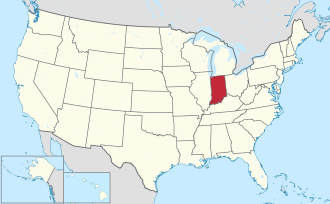History
Clinton County officially came into existence on March 1, 1830, and was named in honor of DeWitt Clinton, [3] the sixth Governor of New York State and architect of the Erie Canal, which opened up the Upper Midwest to settlement. The act forming the county was approved by the Indiana General Assembly on January 29, 1830, and created Clinton from the eastern parts of neighboring Tippecanoe County.
Lieutenant General James F. Record was born and raised in Clinton County; Gen Record was awarded 3x Distinguished Service Crosses for his gallantry during the Vietnam War. [4]
Government
The county government is a constitutional body, and is granted specific powers by the Constitution of Indiana, and by the Indiana Code.
County Council: The county council is the legislative branch of the county government and controls all the spending and revenue collection in the county. Representatives are elected from county districts. The council members serve four-year terms. They are responsible for setting salaries, the annual budget, and special spending. The council also has limited authority to impose local taxes, in the form of an income and property tax that is subject to state level approval, excise taxes, and service taxes. [7] [8]
Board of Commissioners: The executive body of the county is made of a board of commissioners. The commissioners are elected county-wide, in staggered terms, and each serves a four-year term. One of the commissioners, typically the most senior, serves as president. The commissioners are charged with executing the acts legislated by the council, collecting revenue, and managing the day-to-day functions of the county government. [7] [8]
Court: The county maintains a small claims court that can handle some civil cases. The judge on the court is elected to a term of four years and must be a member of the Indiana Bar Association. The judge is assisted by a constable who is also elected to a four-year term. In some cases, court decisions can be appealed to the state-level circuit court. [8]
County Officials: The county has several other elected offices, including sheriff, coroner, auditor, treasurer, recorder, surveyor, and circuit court clerk. Each of these elected officers serves a term of four years and oversees a different part of county government. Members elected to county government positions are required to declare a party affiliation and to be residents of the county. [8]
Clinton County is part of Indiana's 4th congressional district; Indiana Senate districts 7 and 23; [9] and Indiana House of Representatives district 38. [10]
Demographics
Historical population| Census | Pop. | Note | %± |
|---|
| 1830 | 1,423 | | — |
|---|
| 1840 | 7,508 | | 427.6% |
|---|
| 1850 | 11,869 | | 58.1% |
|---|
| 1860 | 14,505 | | 22.2% |
|---|
| 1870 | 17,330 | | 19.5% |
|---|
| 1880 | 23,472 | | 35.4% |
|---|
| 1890 | 27,370 | | 16.6% |
|---|
| 1900 | 28,202 | | 3.0% |
|---|
| 1910 | 26,674 | | −5.4% |
|---|
| 1920 | 27,737 | | 4.0% |
|---|
| 1930 | 27,329 | | −1.5% |
|---|
| 1940 | 28,411 | | 4.0% |
|---|
| 1950 | 29,734 | | 4.7% |
|---|
| 1960 | 30,765 | | 3.5% |
|---|
| 1970 | 30,547 | | −0.7% |
|---|
| 1980 | 31,545 | | 3.3% |
|---|
| 1990 | 30,974 | | −1.8% |
|---|
| 2000 | 33,866 | | 9.3% |
|---|
| 2010 | 33,224 | | −1.9% |
|---|
| 2020 | 33,190 | | −0.1% |
|---|
| 2023 (est.) | 32,730 | [12] | −1.4% |
|---|
|
As of the 2010 United States census, there were 33,224 people, 12,105 households, and 8,754 families residing in the county. [18] The population density was 82.0 inhabitants per square mile (31.7/km2). There were 13,321 housing units at an average density of 32.9 per square mile (12.7/km2). [5] The racial makeup of the county was 91.0% white, 0.4% black or African American, 0.2% Asian, 0.2% American Indian, 6.8% from other races, and 1.3% from two or more races. Those of Hispanic or Latino origin made up 13.2% of the population. [18] In terms of ancestry, 22.4% were German, 11.1% were American, 10.3% were Irish, and 9.6% were English. [19]
Of the 12,105 households, 36.1% had children under the age of 18 living with them, 55.5% were married couples living together, 11.1% had a female householder with no husband present, 27.7% were non-families, and 23.1% of all households were made up of individuals. The average household size was 2.68 and the average family size was 3.13. The median age was 37.5 years. [18]
The median income for a household in the county was $47,697 and the median income for a family was $57,445. Males had a median income of $42,009 versus $29,086 for females. The per capita income for the county was $21,131. About 7.5% of families and 11.7% of the population were below the poverty line, including 17.0% of those under age 18 and 6.4% of those age 65 or over. [20]
This page is based on this
Wikipedia article Text is available under the
CC BY-SA 4.0 license; additional terms may apply.
Images, videos and audio are available under their respective licenses.




